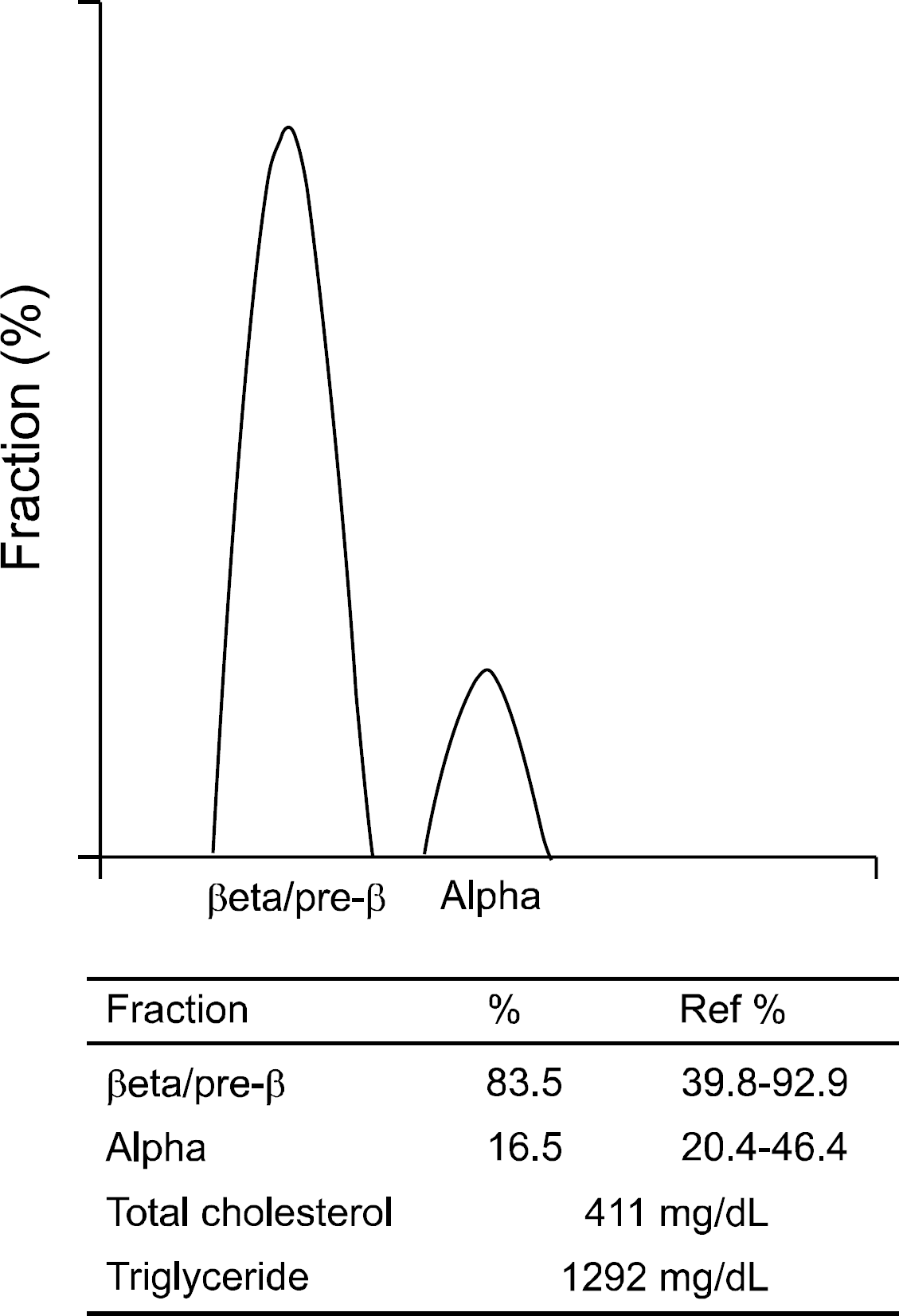Abstract
Heparin and/or insulin stimulate lipoprotein lipase and are known to decrease serum triglyceride level. However, their efficacy in hypertriglyceridemia-induced acute pancreatitis in nondiabetic patients is not well documented. We report a case of hypertriglyceridemia-induced pancreatitis in 43-year-old nondiabetic woman in whom treatment with insulin was accompanied by reduction in serum triglyceride level and the resolution of pancreatitis. She presented to the emergency department with abdominal pain and biochemical evidence of acute pancreatitis. Her medical history was unremarkable. There was no history of alcohol consumption, and biliary imaging was not remarkable. Subsequent laboratory investigation revealed marked hypertriglyceridemia (1,951 mg/dL), impaired fasting glucose, and normal HbAlc level. The Ranson's score and APATCH II score were 1 and 4. Abdominal CT showed diffuse enlargement of pancreas, peripancreatic fat infiltration, and multiple fluid collections around the pancreas. We treated the patient with the infusion of 5% dextrose and 1.5 unit/hr regular insulin to reduce serum triglyceride level. The level of serum triglyceride was decreased to 305 mg/dL on day 5. During the remainder of hospitalization, her clinical symptoms and laboratory values gradually improved.
REFERENCES
1. Fortson MR, Freedman SN, Webster PD 3rd. Clinical assessment of hyperlipidemic pancreatitis. Am J Gastroenterol. 1995; 90:2134–2139.
3. Tsuang W, Navaneethan U, Ruiz L, Palascak JB, Gelrud A. Hypertriglyceridemic pancreatitis: presentation and management. Am J Gastroenterol. 2009; 104:984–991.

4. Chuang TY, Chao CL, Lin BJ, Lu SC. Gestational hyperlipidemic pancreatitis caused by type III hyperlipoproteinemia with apolipoprotein E2/E2 homozygote. Pancreas. 2009; 38:716–717.

5. Muller DP, Pavlou C, Whitelaw AG, McLintock D. The effect of pregnancy and two different contraceptive pills on serum lipids and lipoproteins in a woman with a type III hy-perlipoproteinaemia pattern. Br J Obstet Gynaecol. 1978; 85:127–133.

6. Yoon YK, Ji JH, Mun BS. Hypertriglyceridemia-induced pancreatitis. Korean J Gastroenterol. 2008; 51:309–313.
7. Matthews DR, Hosker JP, Rudenski AS, Naylor BA, Treacher DF, Turner RC. Homeostasis model assessment: insulin resistance and beta-cell function from fasting plasma glucose and insulin concentrations in man. Diabetologia. 1985; 28:412–419.
8. Radikova Z, Koska J, Huckova M, et al. Insulin sensitivity indices: a proposal of cutoff points for simple identification of insulin-resistant subjects. Exp Clin Endocrinol Diabetes. 2006; 114:249–256.

9. Yadav D, Pitchumoni CS. Issues in hyperlipidemic pancreatitis. J Clin Gastroenterol. 2003; 36:54–62.

10. Kim YJ, Kim HJ, Kim HC, Kim SJ, Park SH. A case of acute hyperlipidemic pancreatitis in a patient suspected of familial combined hyperlipidemia. Korean J Med. 2005; 69:197–201.
11. Kimura T, Toung JK, Margolis S, Permutt S, Cameron JL. Respiratory failure in acute pancreatitis: a possible role for triglycerides. Ann Surg. 1979; 189:509–514.
12. Warshaw AL, Lesser PB, Rie M, Cullen DJ. The pathogenesis of pulmonary edema in acute pancreatitis. Ann Surg. 1975; 182:505–510.

13. Hofbauer B, Friess H, Weber A, et al. Hyperlipaemia in-tensifies the course of acute oedematous and acute necrotising pancreatitis in the rat. Gut. 1996; 38:753–758.

14. Brian Haig TH. Experimental pancreatitis intensified by a high fat diet. Surg Gynecol Obstet. 1970; 131:914–918.
15. Szczepiorkowski ZM, Bandarenko N, Kim HC, et al. Guidelines on the use of therapeutic apheresis in clinical practice: evidence-based approach from the Apheresis Appli-cations Committee of the American Society for Apheresis. J Clin Apher. 2007; 22:106–175.
16. Eckel RH. Lipoprotein lipase. A multifunctional enzyme rele-vant to common metabolic diseases. N Engl J Med. 1989; 320:1060–1068.
17. Goldberg IJ. Lipoprotein lipase and lipolysis: central roles in lipoprotein metabolism and atherogenesis. J Lipid Res. 1996; 37:693–707.

18. Ong JM, Kirchgessner TG, Schotz MC, Kern PA. Insulin increases the synthetic rate and messenger RNA level of lipoprotein lipase in isolated rat adipocytes. J Biol Chem. 1988; 263:12933–12938.

19. Korn ED. Clearing factor, a heparin-activated lipoprotein lipase. I. Isolation and characterization of the enzyme from normal rat heart. J Biol Chem. 1955; 215:1–14.
20. Berger Z, Quera R, Poniachik J, Oksenberg D, Guerrero J. Heparin and insulin treatment of acute pancreatitis caused by hypertriglyceridemia. Experience of 5 cases. Rev Med Chil. 2001; 129:1373–1378.
21. Monga A, Arora A, Makkar RP, Gupta AK. Hypertriglycer-idemia-induced acute pancreatitis–treatment with heparin and insulin. Indian J Gastroenterol. 2003; 22:102–103.




 PDF
PDF ePub
ePub Citation
Citation Print
Print




 XML Download
XML Download